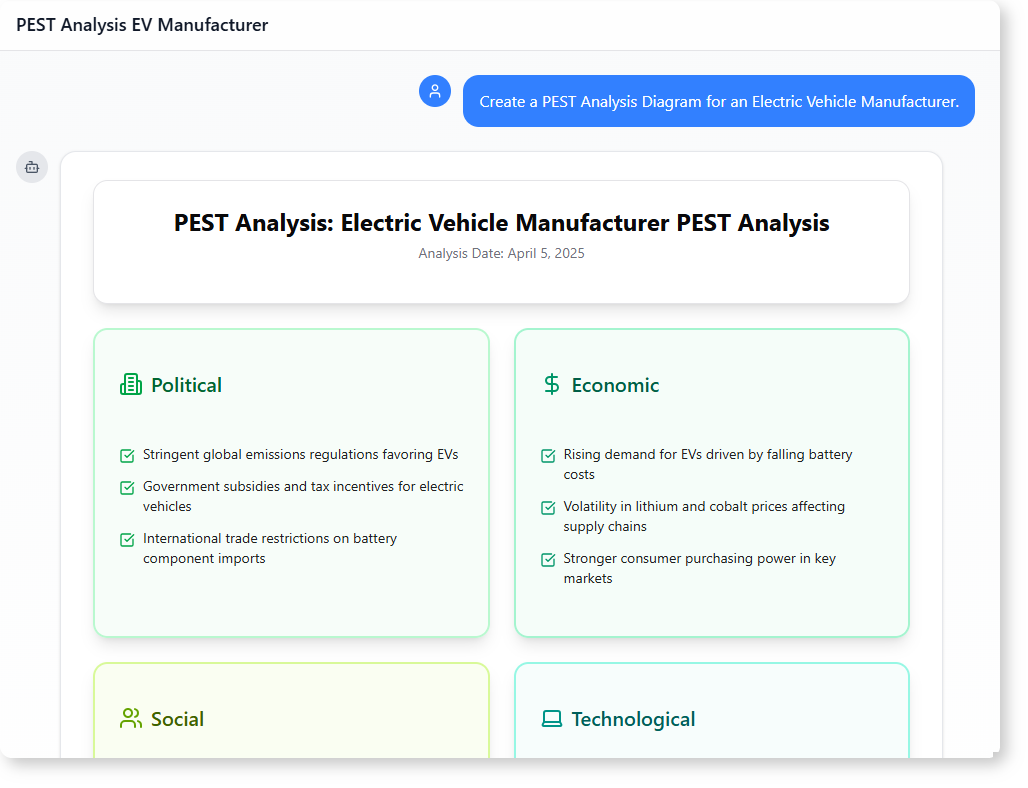Now Reading: How to Generate a PEST Analysis with AI-Powered Modeling Software
-
01
How to Generate a PEST Analysis with AI-Powered Modeling Software
How to Generate a PEST Analysis with AI-Powered Modeling Software
How to Generate a PEST Analysis with AI-Powered Modeling Software
Starting a new project in the automotive sector? You might need to understand the external forces shaping the market. A PEST Analysis helps clarify political, economic, social, and technological trends. But doing it manually can take hours.
With AI-powered modeling software, you can go from a simple prompt to a detailed, well-structured diagram and full narrative report—all in minutes. This isn’t just about drawing a PEST diagram. It’s about getting clear, relevant insights tailored to your industry.

Why This Matters for Electric Vehicle Manufacturers
An electric vehicle (EV) company operates in a rapidly changing environment. From government policies to consumer behavior, many elements affect success. A strong PEST Analysis helps leaders see what’s driving demand, what risks exist, and where innovation is needed.
Without a structured approach, teams might miss key trends—like rising lithium prices or shifts in youth preferences for sustainable transport. That’s where AI-powered modeling software steps in.
Real-World Journey: A User’s PEST Analysis Workflow
Let’s walk through how a business analyst created a PEST Analysis for an EV manufacturer.
Background:
The user is a mid-level strategy consultant working with a startup EV company. Their goal is to assess external factors affecting market entry and long-term growth. They need a clear, visual layout of the PEST factors and detailed explanations for each.
Objective:
They want to understand the key external forces influencing the EV space—not just list them, but interpret how each one impacts the business.
Step-by-Step Interaction with the AI-Powered Modeling Software:
-
First Prompt – ‘Create a PEST Analysis Diagram for an Electric Vehicle Manufacturer.’
The AI generated a clean, organized PEST Analysis diagram with four core categories: Political, Economic, Social, and Technological. Each factor was clearly labeled and grouped logically. -
Second Prompt – ‘Expand the diagram into a full narrative report with explanations for each factor.’
The system responded with a detailed narrative report that explained not just the factors, but their real-world implications. For example:
- Political: Global emissions regulations are pushing governments to support EV adoption. Tax incentives in major markets like Germany and China are making EVs more affordable.
- Economic: Battery costs are dropping, which improves EV affordability. However, volatility in raw material prices—especially lithium and cobalt—creates supply chain risks.
- Social: Younger consumers are increasingly choosing zero-emission vehicles. This shift is not just a trend—it’s reshaping what buyers expect from cars.
- Technological: Fast-charging and solid-state battery advances are improving range and charging times. AI-driven maintenance systems now help drivers optimize charging and usage.
The resulting output is not just a diagram—it’s a strategic foundation for decision-making.
What You Get with AI-Powered Modeling Software
Unlike generic tools that generate placeholder content, this AI-powered modeling software delivers:
- A clear, visually structured PEST diagram that reflects real-world dynamics.
- Detailed, context-rich narrative explanations for each factor.
- Real business insights—like how policy changes or consumer preferences can impact revenue or go-to-market strategies.
The output includes a full understanding of the underlying drivers, which is crucial when preparing business plans or investor presentations.
The Value of AI-Powered Modeling in Strategy
Many tools stop at diagram creation. This one goes further—turning raw data into meaningful narratives. That’s essential when you’re trying to predict market shifts or respond to competitive pressures.
For example, identifying that younger demographics are driving EV demand helps shape marketing efforts. Recognizing volatility in battery materials helps plan supply chain risk management.
This level of insight is rare in traditional PEST tools. With AI-powered modeling software, the process becomes intuitive, accurate, and directly tied to business outcomes.
Common Questions About PEST Analysis
Q: Can AI create a PEST Analysis for any industry?
A: Yes. The AI-powered modeling software is designed to adapt to different sectors—whether it’s transportation, energy, or retail. The key is providing a clear prompt about the industry and business context.
Q: Is the PEST report just a list of factors?
A: No. The software generates a narrative that explains each factor’s relevance and impact. For example, it doesn’t just say ‘lithium prices are high’—it explains how that affects supply chain costs and long-term pricing.
Q: How does the AI ensure the content is relevant?
A: The AI uses industry-specific patterns and real-world context to build accurate, actionable insights. It draws on current trends and reliable data sources to ensure the analysis is grounded in reality.
Q: Can this be used for internal strategy sessions?
A: Absolutely. Teams can use the generated PEST Analysis to discuss market entry, risk exposure, or innovation priorities during planning meetings.
Ready to map out external forces affecting your business? Give our AI-powered modeling software a try at Visual Paradigm’s AI Chatbot today!
